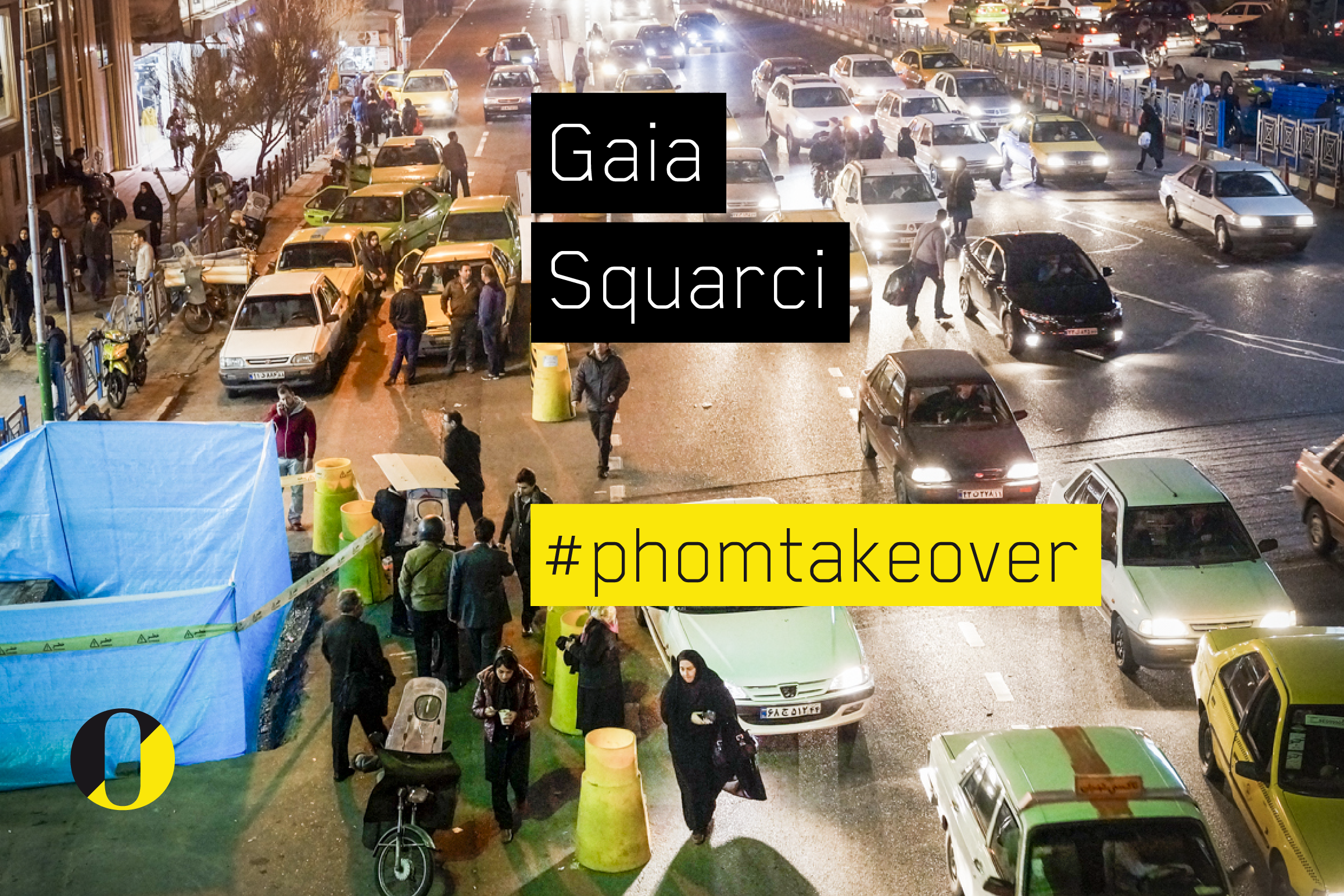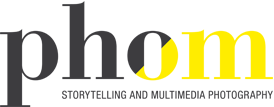Phom ha sempre avuto uno sguardo rivolto ai giovani fotografi, autori talentuosi in cui vediamo il futuro della fotografia, italiana e non. Vogliamo quindi sostenerli e parlare di loro. Possono usare il nostro account come vogliono: per presentare un lavoro già finito, un lavoro in progress o per condividere degli scatti e dei momenti personali.
Collabora con New York Times, New Yorker, Time Magazine, Vogue, Wall Street Journal, MSNBC, VICE, The Guardian, Newsweek e L'Oeil de le Photographie. Ha esposto negli Stati Uniti, Italia, Francia, Svizzera, Messico, Irlanda e Cina.
Le abbiamo fatto qualche domanda sul suo lavoro.
1. “Broken Screen” è uno dei tuoi lavori più particolari, per cui hai preferito usare il bianco e nero. Traspare una certa empatia e la volontà di essere partecipi alla diversa percezione di chi non vede. Cosa vuol dire raccontare la cecità con un mezzo visivo come la fotografia?
L’interesse per la cecità e partito proprio dalla fotografia. Mi sono resa conto di quanto la mia vita sia profondamente permeata di immagini, di quanto influenzino le regole del mondo in cui vivo e le relazioni tra gli esseri umani. Chi non ha più la possibilità di ricevere e scambiare stimoli visivi subisce comunque le dinamiche sociali dettate dalle immagini. Nel momento in cui ho iniziato a fotografare per questo progetto ci e’ voluto un po’ di tempo per trovare il modo giusto di farlo, perché anziché tentare di “spiegare” tramite le fotografie alcuni momenti della vita di chi non vede, il mio intento era quello di portare chi vede ad immedesimarsi nella loro situazione, e a chiedersi come reagirebbero, e come la loro identità nel mondo delle immagini sarebbe intaccata dalla perdita della vista.
2. Hai usato molto il video anche per lavori legati alla performance e alla moda, anche con un approccio diverso da quello documentaristico che hai di solito: ce ne vuoi parlare?
Occasioni legate alla performance e alla moda sono un canale parallelo su cui é diventato importante per me poter lavorare, e in passato e’ capitato che aprissero la strada per storie più ampie. Trovo che l’ambito della fotografia e del video di reportage rischi spesso di chiudersi nell’autoreferenzialità e cerco il più possibile di assorbire nuovi spunti creativi anche da altre circostanze. Dirigere video su richiesta é un lavoro in cui mi trovo a mio agio e che mi stimola molto. Ovviamente nei lavori commissionati ho meno libertà di comunicare esattamente la mia visione, ma cerco di girare in modo che la discussione con il cliente possa avvenire durante il montaggio, così da non rischiare di scontentarlo completamente pur provando a spingere su alcune scelte personali di stile o contenuto. Sono lavori molto diversi da quelli di taglio documentario, ma dietro alla macchina c’è sempre la stessa persona.
3. Sul tuo profilo Instagram troviamo tante immagini personali insieme ad alcune prese dai tuoi lavori: che approccio hai con i social media? Quanto (e come) li sfrutti per il tuo lavoro?
Ho un rapporto piuttosto ambivalente con i social media. Sul piano personale mi divertono, cerco di non prenderli troppo sul serio e nonostante siano un mezzo di comunicazione onnipresente ho cercato di dar loro un posto abbastanza limitato nella mia vita quotidiana. Allo stesso tempo però la loro influenza sui grandi numeri mi sorprende spesso, e a volte mi spaventa. Consapevole dell’impatto che i social media hanno acquistato nel mio campo lavorativo, mentre scelgo immagini di diario da alternare a quelle tratte da progetti fotografici penso sempre al fatto che la maggior parte delle persone che le vedranno fanno parte del mio settore.
4. Ti capita di usare professionalmente le immagini che hai scattato con lo smartphone?
Di rado, ma succede. Di solito scelgo di usare il telefono anzichè la macchina fotografica solo in circostanze particolari, legate o alla posizione dell’inquadratura che sarebbe più complicato realizzare con una macchina tradizionale, oppure al potenziale pericolo nell’essere identificata come fotografa professionista in determinate situazioni. Non ho nulla contro l’uso del telefono per fotografare e forse non mi sono applicata a sufficienza per imparare ad usarlo al massimo delle sue potenzialità, ma, considerando anche il fatto che amo molto scattare di notte, continuo a preferire la velocità, la precisione e la gamma di scelte che offre la macchina fotografica.
Potete vedere con gli occhi di Gaia, dal 18 al 24 gennaio, sul nostro account Instagram @instaphom. Buon viaggio!
Intervista a cura di Gabriele Magazzù
ENGLISH VERSION
This month Phom is kicking off #phomtakeover: a young photographer is going to take over our Instagram account for a week each month so that we can live with them for the time being, see through their eyes and – once more – deepen our analysis in the photographer’s work and all its facets, including the relationship with social media.
Phom has always kept an attentive eye on young photographers and talented authors – people where we’d see the future of photography, both nationally and internationally. So we want to support them and talk with them. They will use our account as they please – to present a completed work or a work-in-progress, or simply share personal shots and moments.
We’re starting with Gaia Squarci this month.
Gaia Squarci is a photographer and video-maker based and working in New York, where she’s a contributor for Prospekt agency.
Raised in Milan, she studied History of Art in Bologna and photojournalism at the International Center of Photography (ICP). In 2014 she attended the Eddie Adams Workshop and she landed a place in the final of the Joop Swart masterclass. In 2015 her works were exhibited within reGerenation3 (a collective about new prospectives of photography) at the Musée de l’Elysée in Lausanne.
Her clients include The New York Times, The New Yorker, Time Magazine, Vogue, The Wall Street Journal, MSNBC, VICE, The Guardian, Newsweek and L'Oeil de le Photographie. Her work has been exhibited in the United States, Italy, France, Switzerland, Mexico, Ireland and China.
We’ve asked her a few questions about her work.
1. “Broken Screen” is one of your most peculiar works, where you opted for black and white. A sense of empathy and willingness to participate to the different perception of those who can’t see emerges from it. What does it mean to recount blindness through a visual means like photography?
My interest in blindness originated from photography, actually. I realized to what extent my life is profoundly imbued with images, and how much they influence the rules of the world I live in, as well as interpersonal relationships. Those who don’t have the chance to receive and exchange visual stimuli are still subjected to the social dynamics connected to images. As I started shooting for this project it took me some time to find the right way to carry it on. Rather than attempting to “explain” a few moments of the lives of blind people through photographs, I aimed at leading those who can see to identify themselves in their situation, ask themselves how they would react – and how their identity in the world of images would be effected by the loss of eyesight.
2. You’ve resorted to video-making also for various works related to fashion and performances – and with a different approach to the documentary one you usually use, too. Could you tell us about it?
Fashion and performance occasions have become a parallel channel for me to work on, and in the past they’ve happened to lead the way to wider stories. I believe that the world of photography and documentary video-making often risks to become self-referential, so I try my best to absorb as many new creative stimuli from different sources as possible. Directing videos on assignment makes me very comfortable and it stimulates me a lot. Obviously, when working on assignment, I have less liberty in terms of communicating my vision exactly, but I still try to shoot in a way that the talk with the client may develop during the editing phase. This way I’ll avoid failing him completely, while still trying to push forward my personal choices with regard to style or content. They’re extremely heterogenous works compared to the documentary ones, but the person behind the camera is the same.
3. Your Instagram account features a number of personal images as well as shots from your works. What’s your approach with social media? To what extent (and how) do you exploit them for your work?
My approach with social media is quite dualistic. On a personal level, they amuse me. I try not to take them too seriously and, despite the fact they are an ubiquitous means of communication, I’ve tried to give them limited room in my everyday life. However, I’m also surprised at the influence they have on a mass level, and it does scare me sometimes. While I’m aware of the impact that social media have gained in my field of work, as I browse through diary images to alternate with shots from photographic projects, I’m always mindful of the fact that most viewers belong to my field of work.
4. Do you happen to use pictures taken with your smartphone for professional projects?
Rarely, but it does happen. I usually opt for my smartphone instead of my camera only under particular circumstances, which are linked to either the positioning of the framing (which would be harder to do with a traditional camera), or the potential risk of being recognized as a professional photographic in given situations. I’m not against the use of smartphones to take photos at all, and perhaps I haven’t committed enough to learning to use them at their best. Still, also considering the fact that I love to shoot at night, I keep preferring the speed, precision and wide range of choices that the camera offers.
You can follow her from January 18 to 24 on our Instagram account @instaphom. Enjoy the journey with Gaia!
Interview by Gabriele Magazzù


Leave a Reply